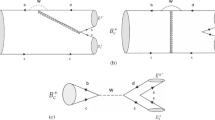Abstract
The exclusive decay of B + → D + K 0 is calculated by the QCD factorization method (QCDF) and final state interaction (FSI). First, the B + → D + K 0 decay is calculated via QCDF method. The result that is found by using the QCDF method is less than the experimental result. So FSI is considered to solve the B + → D + K 0 decay. For this decay, the D + s π0, D + s *ρ0, D + s *ϕ via the exchange of \(\bar K^0\), \(\bar K^{0*} \), D −, and D −* mesons are chosen for the intermediate states. The above intermediate states are calculated by using the QCDF method. In the FSI effects, the results of our calculations depend on η as the phenomenological parameter. The range of this parameter is selected from 2 to 2.4. It is found that if η = 2.4 is selected, the numbers of the branching ratio are placed in the experimental range. The experimental branching ratio of this decay is less than 2.9 × 10−6 and our results calculated by QCDF and FSI are (0.16 ± 0.04) × 10−6 and (2.8 ± 0.09) × 10−6, respectively.
Similar content being viewed by others
References
H. Y. Cheng, C. K. Chua, and A. Soni, Phys. Rev. D 71, 014030 (2005).
Y. S. Oh, T. Song, and S. H. Lee, Phys. Rev. C 63, 034901 (2001).
V. M. Belyaev, V. M. Braun, A. Khodjamirian, and R. Ruckl, Phys. Rev. D 51, 6177 (1995).
J. F. Donoghue, E. Glowich, A. A. Petrow, and J. M. Soares, Phys. Rev. Lett. 77, 2178 (1996).
M. Beneke, G. Buchalla, M. Neubert, and C. T. Sachrajda, Nucl. Phys. B 591, 313 (2000).
A. Ali and C. Greub, Phys. Rev. D 57, 2996 (1998).
M. Beneke, G. Buchalla, M. Neubert, and C. T. Sachrajda, Nucl. Phys. B 606, 245 (2001).
X. Liu, Z. T. Wei, and X. Q. Li, Eur. Phys. J. C 59, 683 (2009).
K. Nakamura et al. (Particle Data Group), Nucl. Part. Phys. 37, 075021 (2012).
X. Liu, B. Zhang, L. L. Shen, and S. L. Zhu, Phys. Rev. D 75, 074017 (2007).
C. D. Lu, Y. L. Shen, and W. Wang, Phys. Rev. D 73, 034005 (2006).
Q. Zhao and B. S. Zou, Phys. Rev. D 74, 114025 (2006).
A. Ali, G. Kramer, and C. D. Lu, Phys. Rev. D 58, 094009 (1998).
M. Beneke and M. Neubert, Nucl. Phys. B 675, 333 (2003).
C. W. Hwang, Phys. Rev. D 81, 114024 (2010).
Author information
Authors and Affiliations
Corresponding author
Additional information
The article is published in the original.
Rights and permissions
About this article
Cite this article
Mehraban, H., Borhani, M. & Asadi, A. Final state interaction effects in the B + → D + K 0 decay. Jetp Lett. 100, 285–294 (2014). https://doi.org/10.1134/S002136401417010X
Received:
Published:
Issue Date:
DOI: https://doi.org/10.1134/S002136401417010X



